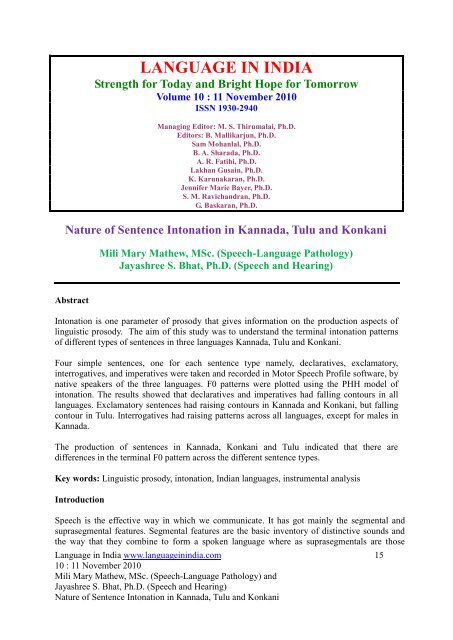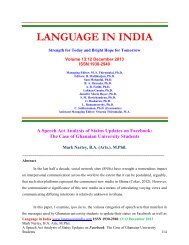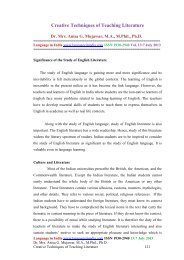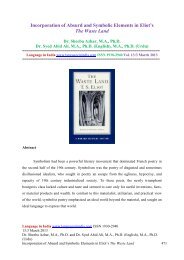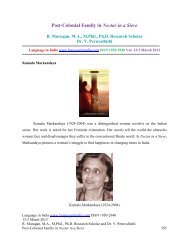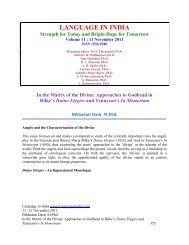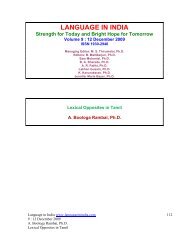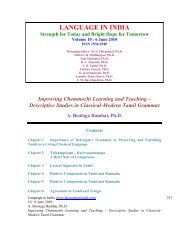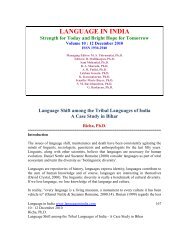nature of sentence intonation in kannada, tulu ... - Language in India
nature of sentence intonation in kannada, tulu ... - Language in India
nature of sentence intonation in kannada, tulu ... - Language in India
You also want an ePaper? Increase the reach of your titles
YUMPU automatically turns print PDFs into web optimized ePapers that Google loves.
LANGUAGE IN INDIA<br />
Strength for Today and Bright Hope for Tomorrow<br />
Volume 10 : 11 November 2010<br />
ISSN 1930-2940<br />
Manag<strong>in</strong>g Editor: M. S. Thirumalai, Ph.D.<br />
Editors: B. Mallikarjun, Ph.D.<br />
Sam Mohanlal, Ph.D.<br />
B. A. Sharada, Ph.D.<br />
A. R. Fatihi, Ph.D.<br />
Lakhan Gusa<strong>in</strong>, Ph.D.<br />
K. Karunakaran, Ph.D.<br />
Jennifer Marie Bayer, Ph.D.<br />
S. M. Ravichandran, Ph.D.<br />
G. Baskaran, Ph.D.<br />
Nature <strong>of</strong> Sentence Intonation <strong>in</strong> Kannada, Tulu and Konkani<br />
Abstract<br />
Mili Mary Mathew, MSc. (Speech-<strong>Language</strong> Pathology)<br />
Jayashree S. Bhat, Ph.D. (Speech and Hear<strong>in</strong>g)<br />
Intonation is one parameter <strong>of</strong> prosody that gives <strong>in</strong>formation on the production aspects <strong>of</strong><br />
l<strong>in</strong>guistic prosody. The aim <strong>of</strong> this study was to understand the term<strong>in</strong>al <strong><strong>in</strong>tonation</strong> patterns<br />
<strong>of</strong> different types <strong>of</strong> <strong>sentence</strong>s <strong>in</strong> three languages Kannada, Tulu and Konkani.<br />
Four simple <strong>sentence</strong>s, one for each <strong>sentence</strong> type namely, declaratives, exclamatory,<br />
<strong>in</strong>terrogatives, and imperatives were taken and recorded <strong>in</strong> Motor Speech Pr<strong>of</strong>ile s<strong>of</strong>tware, by<br />
native speakers <strong>of</strong> the three languages. F0 patterns were plotted us<strong>in</strong>g the PHH model <strong>of</strong><br />
<strong><strong>in</strong>tonation</strong>. The results showed that declaratives and imperatives had fall<strong>in</strong>g contours <strong>in</strong> all<br />
languages. Exclamatory <strong>sentence</strong>s had rais<strong>in</strong>g contours <strong>in</strong> Kannada and Konkani, but fall<strong>in</strong>g<br />
contour <strong>in</strong> Tulu. Interrogatives had rais<strong>in</strong>g patterns across all languages, except for males <strong>in</strong><br />
Kannada.<br />
The production <strong>of</strong> <strong>sentence</strong>s <strong>in</strong> Kannada, Konkani and Tulu <strong>in</strong>dicated that there are<br />
differences <strong>in</strong> the term<strong>in</strong>al F0 pattern across the different <strong>sentence</strong> types.<br />
Key words: L<strong>in</strong>guistic prosody, <strong><strong>in</strong>tonation</strong>, <strong>India</strong>n languages, <strong>in</strong>strumental analysis<br />
Introduction<br />
Speech is the effective way <strong>in</strong> which we communicate. It has got ma<strong>in</strong>ly the segmental and<br />
suprasegmental features. Segmental features are the basic <strong>in</strong>ventory <strong>of</strong> dist<strong>in</strong>ctive sounds and<br />
the way that they comb<strong>in</strong>e to form a spoken language where as suprasegmentals are those<br />
<strong>Language</strong> <strong>in</strong> <strong>India</strong> www.language<strong>in</strong><strong>in</strong>dia.com 15<br />
10 : 11 November 2010<br />
Mili Mary Mathew, MSc. (Speech-<strong>Language</strong> Pathology) and<br />
Jayashree S. Bhat, Ph.D. (Speech and Hear<strong>in</strong>g)<br />
Nature <strong>of</strong> Sentence Intonation <strong>in</strong> Kannada, Tulu and Konkani
features that <strong>in</strong>fluences the way the sounds are processed for mean<strong>in</strong>g. Suprasegmental features<br />
are also called as prosodic features. Segmental features alone do not serve the purpose <strong>of</strong><br />
communication. Communication becomes mean<strong>in</strong>gful only when the supra segmental features<br />
are imposed and is useful <strong>in</strong> speech production as well as perception.<br />
Prosody serves a variety <strong>of</strong> functions <strong>in</strong> language process<strong>in</strong>g. Functionally prosody may convey<br />
both l<strong>in</strong>guistic and affective contents based on which prosody can be classified as l<strong>in</strong>guistic<br />
prosody and emotional prosody Vivian & Hielscher, 2004. Emotional prosody is def<strong>in</strong>ed as the<br />
ability to express emotions where as L<strong>in</strong>guistic prosody is used to disambiguate or to mark the<br />
<strong>in</strong>ternal organization <strong>of</strong> <strong>sentence</strong> constituents or to convey the <strong><strong>in</strong>tonation</strong> contour <strong>of</strong> a <strong>sentence</strong><br />
(Lieberman, 1968).<br />
Research has <strong>in</strong>dicated that right hemisphere dom<strong>in</strong>ates for decod<strong>in</strong>g affective prosody whereas<br />
the left is dom<strong>in</strong>ant for the l<strong>in</strong>guistic prosody. There are also evidences from the bra<strong>in</strong> damaged<br />
<strong>in</strong>dividuals that substantiate these views. Right hemisphere damaged <strong>in</strong>dividuals have been<br />
reported to perform poorly <strong>in</strong> the perception and production <strong>of</strong> emotive <strong><strong>in</strong>tonation</strong> compared to<br />
left hemisphere damaged or non-bra<strong>in</strong> damaged (Ross, 1981). Damage to both the cortical and<br />
subcortical structures can give rise to impaired speech prosody (Kent & Rosenbeck, 1982).<br />
Intonation, Rhythm and Stress<br />
Intonation, rhythm and stress are classically understood as prosodic parameters. Rhythm is the<br />
variation <strong>of</strong> the length and accentuation <strong>of</strong> a series <strong>of</strong> sounds or other events. Stress is<br />
understood as a comparative force with which particular syllable with<strong>in</strong> the group <strong>of</strong> syllable<br />
are pronounced. Intonation is def<strong>in</strong>ed as the variation <strong>in</strong> pitch superimposed on the <strong>sentence</strong>s<br />
(Bol<strong>in</strong>ger, 1972). Acoustically, the prosodies <strong>of</strong> oral language <strong>in</strong>volves variation <strong>in</strong> syllable<br />
length, loudness, pitch, and the formant frequencies <strong>of</strong> speech sounds.<br />
Speakers use <strong><strong>in</strong>tonation</strong> patterns to help them express their ideas or emotions. Intonation<br />
conveys mean<strong>in</strong>gs that apply to phrase or utterances as a whole, such as <strong>sentence</strong> type or<br />
speech act, or focus and <strong>in</strong>formation structure. Intonation patterns are specified as an abstract<br />
sequence <strong>of</strong> high and low tones. These tones have no absolute physical value. Rather, they are<br />
implemented relative to each other through the manipulation <strong>of</strong> pitch and the fundamental<br />
frequency (F0) <strong>of</strong> the voice (Ladd 1996). These are as shown <strong>in</strong> Table 1.<br />
Table 1: The F0 variation for different <strong><strong>in</strong>tonation</strong> types<br />
S No: INTONATION TYPES PITCH/AMPLITUDE CONTOUR<br />
1. FALL /LOW TONE<br />
2. FALL-RISE<br />
<strong>Language</strong> <strong>in</strong> <strong>India</strong> www.language<strong>in</strong><strong>in</strong>dia.com 16<br />
10 : 11 November 2010<br />
Mili Mary Mathew, MSc. (Speech-<strong>Language</strong> Pathology) and<br />
Jayashree S. Bhat, Ph.D. (Speech and Hear<strong>in</strong>g)<br />
Nature <strong>of</strong> Sentence Intonation <strong>in</strong> Kannada, Tulu and Konkani
3. RISE<br />
4. RISE-FALL<br />
Some researchers also analyze <strong><strong>in</strong>tonation</strong> accord<strong>in</strong>g to the PHH model proposed by<br />
Pierrehumbert and Hirschberg (1990). The model’s units are the simplest possible code levels<br />
<strong>of</strong> relative pitch: High pitched peaks, H: low pitched regions, L: and comb<strong>in</strong>ation <strong>of</strong> these<br />
events with stress (*) and end <strong>of</strong> utterance (%). Thus, the F0 patterns are described as a series<br />
<strong>of</strong> high and low tones relative to each other.<br />
L<strong>in</strong>guistic Prosody<br />
Studies on production aspects <strong>of</strong> l<strong>in</strong>guistic prosody have addressed the patterns or contours <strong>of</strong><br />
change <strong>in</strong> fundamental frequency (F0) for different types <strong>of</strong> <strong>sentence</strong>s. Most <strong>of</strong> the languages<br />
have 4 types <strong>of</strong> <strong>sentence</strong>s, declaratives, <strong>in</strong>terrogatives, exclamatory and imperatives. A <strong>sentence</strong><br />
<strong>in</strong> the form <strong>of</strong> a statement is called as declarative <strong>sentence</strong>. An exclamatory <strong>sentence</strong> is to<br />
express strong feel<strong>in</strong>gs by mak<strong>in</strong>g an exclamation. A <strong>sentence</strong> that gives advice or <strong>in</strong>structions<br />
or that expresses a request or a command is termed as imperative <strong>sentence</strong> and the form <strong>of</strong><br />
<strong>sentence</strong> used for ask<strong>in</strong>g questions is <strong>in</strong>terrogative (Richard, 2003).<br />
A study done on Japanese and Russian languages reported that there is an <strong>in</strong>crease <strong>in</strong> the<br />
height or magnitude <strong>of</strong> a rise for the <strong><strong>in</strong>tonation</strong> pattern <strong>of</strong> a declarative <strong>sentence</strong> <strong>in</strong> both<br />
languages (Makarova, 2000). Another study concluded that there is a rais<strong>in</strong>g term<strong>in</strong>al contour<br />
<strong>in</strong> the exclamatory <strong>sentence</strong> <strong>in</strong> English. (Bol<strong>in</strong>ger,1989). Quirk et al. (1985) claimed that<br />
imperative <strong>sentence</strong> frequently has a tone unit to itself, especially <strong>in</strong> f<strong>in</strong>al position with a ris<strong>in</strong>g<br />
tone.<br />
Accord<strong>in</strong>g to Bassano and Mendes (1994) <strong>in</strong> French language declaratives and exclamatives<br />
were <strong>of</strong> fall<strong>in</strong>g <strong><strong>in</strong>tonation</strong> pattern, <strong>in</strong>terrogatives were <strong>of</strong> ris<strong>in</strong>g and imperatives split between<br />
fall<strong>in</strong>g and ris<strong>in</strong>g contours depend<strong>in</strong>g on their specific functions. Fall<strong>in</strong>g <strong><strong>in</strong>tonation</strong> is reported<br />
to <strong>in</strong>dicate a declarative utterance, while a ris<strong>in</strong>g <strong><strong>in</strong>tonation</strong> contour declares an <strong>in</strong>terrogative<br />
utterance <strong>in</strong> German (Raithel & Hielscher, 2004). Commands are found to have no salient<br />
contour.<br />
Studies on L<strong>in</strong>guistic Prosody <strong>in</strong> <strong>India</strong>n <strong>Language</strong>s<br />
Few studies on <strong><strong>in</strong>tonation</strong> patterns <strong>of</strong> <strong>sentence</strong>s have also been done <strong>in</strong> <strong>India</strong>n languages. A<br />
comparative study on the <strong><strong>in</strong>tonation</strong> pattern <strong>of</strong> declarative <strong>sentence</strong> <strong>in</strong> Chattisgarhi and<br />
Khariboli speakers done by Manish, Chongtham and Rakesh (2008) reported that Chattisgarhi<br />
speakers produce declaratives with a fall<strong>in</strong>g pattern, Khariboli speakers show a rais<strong>in</strong>g pattern.<br />
In Kannada, it has been reported that there is no significant ris<strong>in</strong>g or fall<strong>in</strong>g contour to mark a<br />
statement effectively as a question (Suma & Manjula, 2007).<br />
<strong>Language</strong> <strong>in</strong> <strong>India</strong> www.language<strong>in</strong><strong>in</strong>dia.com 17<br />
10 : 11 November 2010<br />
Mili Mary Mathew, MSc. (Speech-<strong>Language</strong> Pathology) and<br />
Jayashree S. Bhat, Ph.D. (Speech and Hear<strong>in</strong>g)<br />
Nature <strong>of</strong> Sentence Intonation <strong>in</strong> Kannada, Tulu and Konkani
But, there is a dearth <strong>of</strong> studies <strong>in</strong> <strong>India</strong>n languages address<strong>in</strong>g the location and direction <strong>of</strong> F0<br />
change <strong>in</strong> a speech segment. And it is evident from the above studies that the <strong><strong>in</strong>tonation</strong><br />
patterns do not follow a universal trend, it varies across languages.<br />
Be<strong>in</strong>g a multil<strong>in</strong>gual country, <strong>in</strong> <strong>India</strong>, there is a wealth <strong>of</strong> <strong>in</strong>formation to be obta<strong>in</strong>ed by<br />
study<strong>in</strong>g the aspects <strong>of</strong> <strong><strong>in</strong>tonation</strong> patterns <strong>in</strong> the various languages. This would provide a<br />
speech language pathologist an understand<strong>in</strong>g on the normal and abnormal aspects <strong>of</strong> prosody,<br />
which will <strong>in</strong> turn aid <strong>in</strong> the assessment and management <strong>of</strong> prosodic errors <strong>in</strong> <strong>in</strong>dividuals with<br />
communication disorders. This would also throw some light on the parameters <strong>of</strong> prosody that<br />
need to be <strong>in</strong>corporated for the synthesis <strong>of</strong> speech <strong>in</strong> the <strong>India</strong>n languages.<br />
Need <strong>of</strong> the Study<br />
Study <strong>of</strong> prosody <strong>in</strong> any language yields <strong>in</strong>formation on the essential suprasegmental aspects <strong>of</strong><br />
speech which adds mean<strong>in</strong>g and melody to a speaker’s production. Knowledge <strong>of</strong> the normal<br />
patterns <strong>of</strong> prosody aids <strong>in</strong> the understand<strong>in</strong>g <strong>of</strong> abnormal aspects, as <strong>in</strong> the case <strong>of</strong><br />
communication disorders. Also, such database can also be <strong>in</strong>corporated <strong>in</strong> the corpus for speech<br />
synthesis.<br />
Synthetic speech is widely be<strong>in</strong>g used <strong>in</strong> the field <strong>of</strong> mass media and communication as well as<br />
<strong>in</strong> the field <strong>of</strong> speech and hear<strong>in</strong>g, especially with respect to the development <strong>of</strong> speech stimuli<br />
as part <strong>of</strong> test procedures.<br />
Thus, an attempt is be<strong>in</strong>g made <strong>in</strong> this study to understand the term<strong>in</strong>al <strong><strong>in</strong>tonation</strong> pattern, for<br />
different <strong>sentence</strong> types <strong>in</strong> three languages be<strong>in</strong>g spoken <strong>in</strong> the city <strong>of</strong> Mangalore; Kannada,<br />
Tulu and Konkani. Kannada forms the <strong>of</strong>ficial language <strong>in</strong> this city, while Tulu and Konkani<br />
are be<strong>in</strong>g spoken by culturally different sects <strong>of</strong> the population.<br />
Objective <strong>of</strong> the Study<br />
This study aims at understand<strong>in</strong>g the term<strong>in</strong>al <strong><strong>in</strong>tonation</strong> patterns <strong>in</strong> three languages, Kannada,<br />
Tulu and Konkani, for different types <strong>of</strong> <strong>sentence</strong>s and also to document if there are differences<br />
<strong>in</strong> the patterns produced by male and female speakers <strong>of</strong> the respective languages.<br />
Method<br />
Participants<br />
Twelve participants were considered for the study. They were divided as native speakers <strong>of</strong><br />
Kannada, Tulu and Konkani, with two males and two females for each <strong>of</strong> the languages. All the<br />
participants were <strong>in</strong> the age range <strong>of</strong> 18-40 years. They were normal healthy <strong>in</strong>dividuals,<br />
devoid <strong>of</strong> speech, language problems, neurological problems and hear<strong>in</strong>g problems.<br />
Protocol<br />
a) Preparation <strong>of</strong> test stimuli: Four <strong>sentence</strong> types were considered, namely, declaratives,<br />
exclamatory, <strong>in</strong>terrogatives, and imperatives. Simple <strong>sentence</strong>s, one under <strong>sentence</strong> type,<br />
<strong>Language</strong> <strong>in</strong> <strong>India</strong> www.language<strong>in</strong><strong>in</strong>dia.com 18<br />
10 : 11 November 2010<br />
Mili Mary Mathew, MSc. (Speech-<strong>Language</strong> Pathology) and<br />
Jayashree S. Bhat, Ph.D. (Speech and Hear<strong>in</strong>g)<br />
Nature <strong>of</strong> Sentence Intonation <strong>in</strong> Kannada, Tulu and Konkani
andomly chosen from text books served as test stimuli <strong>in</strong> all the three languages.<br />
b) Instrumentation: Motor Speech Pr<strong>of</strong>ile s<strong>of</strong>tware (MSP) <strong>of</strong> Computerized Speech Lab 4150<br />
from Kay Elemetrics, was used.<br />
c) Procedure: The record<strong>in</strong>g was done <strong>in</strong> a sound treated room, with the participants seated on a<br />
comfortable chair and the microphone <strong>of</strong> the CSL hardware was placed at a constant distance<br />
<strong>of</strong> 10 cm away from the mouth. The participants were visually presented with the <strong>sentence</strong>s<br />
written on cards one by one and <strong>in</strong>structed to say the <strong>sentence</strong>s. They were also provided with a<br />
model <strong>of</strong> each <strong>sentence</strong> with the appropriate <strong><strong>in</strong>tonation</strong> pattern. Each <strong>sentence</strong> was recorded<br />
thrice and the second repetition was considered for the analysis.<br />
d) Analysis: The F0 patterns for all the <strong>sentence</strong>s were plotted from CSL, by an experienced<br />
speech language pathologist, us<strong>in</strong>g the PHH model <strong>of</strong> <strong><strong>in</strong>tonation</strong>; H for high tone, L for low<br />
tone, (*) to mark the stress and (%) to mark the end <strong>of</strong> utterance. the term<strong>in</strong>al F0 contours were<br />
noted.<br />
For the acoustic analysis, the follow<strong>in</strong>g parameters from MSP were considered: (1) rfo (runn<strong>in</strong>g<br />
speech average fundamental frequency , /Hz/)- this is the average Fo <strong>of</strong> dur<strong>in</strong>g the vocalization;<br />
(2) rFhi (runn<strong>in</strong>g speech highest fundamental frequency, /Hz/)- this is the highest Fo dur<strong>in</strong>g the<br />
vocalization; (3) rFLo (runn<strong>in</strong>g speech lowest fundamental frequency, /Hz/)- this is the lowest<br />
Fo dur<strong>in</strong>g vocalization; (4) rvFo (runn<strong>in</strong>g variability , /%/)- this is a parameter which tracks the<br />
degree <strong>of</strong> pitch variability; (5) rvAm (amplitude variability , /%/)- this is a parameter which<br />
tracks the degree <strong>of</strong> amplitude variability. The analysis was carried out separately for Kannada,<br />
Tulu and Konkani.<br />
The read<strong>in</strong>gs from MSP were subjected to statistical analysis, us<strong>in</strong>g Mann Whitney U Test<br />
(SPSS Version 16) to explore the possibilities <strong>of</strong> gender differences <strong>in</strong> the production<br />
<strong><strong>in</strong>tonation</strong>. The analysis was carried out separately for Kannada, Tulu and Konkani.<br />
Results and Discussion<br />
The results on the study <strong>of</strong> <strong><strong>in</strong>tonation</strong> patterns for four types <strong>of</strong> <strong>sentence</strong>s <strong>in</strong> Kannada, Tulu and<br />
Konkani are as discussed below.<br />
With<strong>in</strong> each language, the F0 patterns did not vary among the subjects <strong>of</strong> each gender. This was<br />
observed throughout for all the <strong>sentence</strong> types under consideration, thus only one pattern has<br />
been plotted for reference. These patterns <strong>of</strong> the F0 variations plotted for the <strong>sentence</strong> types <strong>in</strong><br />
Kannada, Tulu and Konkani are as given <strong>in</strong> Table 2.<br />
Table 2: Intonation patterns <strong>of</strong> Kannada, Tulu and Konkani<br />
Sentence<br />
Type<br />
Kannada Tulu Konakani<br />
Females:<br />
Males:<br />
Females:<br />
Males:<br />
Females:<br />
Males:<br />
<strong>Language</strong> <strong>in</strong> <strong>India</strong> www.language<strong>in</strong><strong>in</strong>dia.com 19<br />
10 : 11 November 2010<br />
Mili Mary Mathew, MSc. (Speech-<strong>Language</strong> Pathology) and<br />
Jayashree S. Bhat, Ph.D. (Speech and Hear<strong>in</strong>g)<br />
Nature <strong>of</strong> Sentence Intonation <strong>in</strong> Kannada, Tulu and Konkani
Declarative<br />
Exclamatory<br />
Imperative<br />
Interrogative<br />
In Kannada, the pattern <strong>of</strong> the declarative <strong>sentence</strong> for females was represented as LH*L% and<br />
for males were as HLH*LHL%. The pattern <strong>of</strong> the exclamatory <strong>sentence</strong> was HLHLH*LH%<br />
for females and LHLH*LH% for males. For imperative <strong>sentence</strong> the pattern was HLH*LHL%<br />
for females and LH*L% for males. The <strong>in</strong>terrogative <strong>sentence</strong> was marked LH*LHLH% for<br />
females and HLHLH*L% for males.<br />
In summary, it can be seen that the term<strong>in</strong>al pitch contour for declaratives and imperatives was<br />
HL, a fall<strong>in</strong>g contour. This was common for both male and female participants. Exclamatory<br />
<strong>sentence</strong> was marked by a rais<strong>in</strong>g contour, HL, <strong>in</strong> both males and females. The term<strong>in</strong>al<br />
contour varied between the genders for <strong>in</strong>terrogatives with females hav<strong>in</strong>g a rais<strong>in</strong>g and males<br />
hav<strong>in</strong>g a fall<strong>in</strong>g contour.<br />
In Tulu, for declarative <strong>sentence</strong> the <strong><strong>in</strong>tonation</strong> pattern was HLH*L% for females and males.<br />
HLH*L% for males were the <strong><strong>in</strong>tonation</strong> pattern. The pattern for the exclamatory <strong>sentence</strong> was<br />
LHLH*L% for females and LHLH*LHL% for males. For imperative <strong>sentence</strong> the pattern was<br />
LHL-LH*LHL % for females and LH*L% for males. The <strong>in</strong>terrogative <strong>sentence</strong> was marked<br />
LH*LHLH% for females and LHLH*LH% for males.<br />
In summary, it can be seen that the term<strong>in</strong>al pitch contour for declarative, exclamatory, and<br />
imperatives was HL, a fall<strong>in</strong>g contour. This was common for both male and female<br />
participants. The <strong>in</strong>terrogatives had a rais<strong>in</strong>g term<strong>in</strong>al contour, marked as LH. This was<br />
common for both genders.<br />
In Konkani, LH* LHL% and LH*LHLHL% marked the declarative <strong>sentence</strong> for females and<br />
males respectively. The pattern for the exclamatory <strong>sentence</strong> was LHLH*LH% for females and<br />
HLH*LH% for males. For imperative <strong>sentence</strong> the pattern was HLH*L% for females and<br />
LH*LHL for males. The <strong>in</strong>terrogative <strong>sentence</strong> was marked LH*LH% for females and<br />
HLH*LH% for males.<br />
In summary, it can be understood that the term<strong>in</strong>al pitch contour for declaratives and<br />
imperatives was HL, a fall<strong>in</strong>g contour. The exclamatory and the <strong>in</strong>terrogative <strong>sentence</strong>s had a<br />
<strong>Language</strong> <strong>in</strong> <strong>India</strong> www.language<strong>in</strong><strong>in</strong>dia.com 20<br />
10 : 11 November 2010<br />
Mili Mary Mathew, MSc. (Speech-<strong>Language</strong> Pathology) and<br />
Jayashree S. Bhat, Ph.D. (Speech and Hear<strong>in</strong>g)<br />
Nature <strong>of</strong> Sentence Intonation <strong>in</strong> Kannada, Tulu and Konkani
ais<strong>in</strong>g pattern, LH. This was common for both genders.<br />
A Comparison <strong>of</strong> the Results Obta<strong>in</strong>ed for Kannada, Tulu and Konkani<br />
The results <strong>of</strong> the acoustical analysis for the <strong>sentence</strong> types across Kannada, Tulu and Konkani<br />
are as shown <strong>in</strong> Table 3.<br />
Table 3: Mean <strong>of</strong> F0 pattern <strong>in</strong> Kannada, Konkani and Tulu for the 4 <strong>sentence</strong> types<br />
<strong>Language</strong> <strong>in</strong> <strong>India</strong> www.language<strong>in</strong><strong>in</strong>dia.com 21<br />
10 : 11 November 2010<br />
Mili Mary Mathew, MSc. (Speech-<strong>Language</strong> Pathology) and<br />
Jayashree S. Bhat, Ph.D. (Speech and Hear<strong>in</strong>g)<br />
Nature <strong>of</strong> Sentence Intonation <strong>in</strong> Kannada, Tulu and Konkani
Parameters rfo<br />
<strong>Language</strong> Sentence<br />
type<br />
Kannada<br />
Tulu<br />
Konkani<br />
Declarative<br />
Exclamatory<br />
Imperative<br />
Interrogative<br />
Declarative<br />
Exclamatory<br />
Imperative<br />
Interrogative<br />
Declarative<br />
Exclamatory<br />
Imperative<br />
Interrogative<br />
Mean Z P<br />
value<br />
<strong>Language</strong> <strong>in</strong> <strong>India</strong> www.language<strong>in</strong><strong>in</strong>dia.com 22<br />
10 : 11 November 2010<br />
Mili Mary Mathew, MSc. (Speech-<strong>Language</strong> Pathology) and<br />
Jayashree S. Bhat, Ph.D. (Speech and Hear<strong>in</strong>g)<br />
Nature <strong>of</strong> Sentence Intonation <strong>in</strong> Kannada, Tulu and Konkani<br />
rfhi<br />
Mean Z P<br />
value<br />
rflo<br />
Mean Z Z P<br />
value<br />
rvfo<br />
Mean Z P<br />
value<br />
M F M F M F M F M F<br />
1.50<br />
1.50<br />
1.50<br />
1.50<br />
1.50<br />
1.50<br />
2.00<br />
1.50<br />
1.50<br />
1.50<br />
2.00<br />
1.50<br />
3.50<br />
3.50<br />
3.50<br />
3.50<br />
3.50<br />
3.50<br />
3.00<br />
3.50<br />
3.50<br />
3.50<br />
3.00<br />
3.50<br />
-1.54<br />
-1.63<br />
-1.54<br />
-1.54<br />
-1.54<br />
-1.54<br />
-.775<br />
-1.54<br />
-1.54<br />
-1.54<br />
-.775<br />
-1.54<br />
.121<br />
.102<br />
.121<br />
.121<br />
.121<br />
.121<br />
.439<br />
.121<br />
.121<br />
.121<br />
.439<br />
.121<br />
1.50<br />
1.50<br />
1.50<br />
1.50<br />
1.50<br />
1.50<br />
1.50<br />
1.50<br />
1.50<br />
2.50<br />
2.50<br />
1.50<br />
3.50<br />
3.50<br />
3.50<br />
3.50<br />
3.50<br />
3.50<br />
3.50<br />
3.50<br />
3.50<br />
2.50<br />
2.50<br />
3.50<br />
-1.54<br />
-1.63<br />
-1.54<br />
-1.54<br />
-1.54<br />
-1.54<br />
-1.54<br />
-1.54<br />
-1.54<br />
1.00<br />
1.00<br />
-1.54<br />
.121<br />
.102<br />
.121<br />
.121<br />
.121<br />
.121<br />
.121<br />
.121<br />
.121<br />
.000<br />
.000<br />
.121<br />
1.50<br />
1.50<br />
2.00<br />
1.50<br />
1.50<br />
1.50<br />
2.00<br />
1.50<br />
1.50<br />
2.00<br />
1.50<br />
1.50<br />
3.50<br />
3.50<br />
3.00<br />
3.50<br />
3.50<br />
3.50<br />
3.00<br />
3.50<br />
3.50<br />
3.00<br />
3.50<br />
3.50<br />
-1.54<br />
-1.63<br />
-.775<br />
-.775<br />
-1.54<br />
-1.54<br />
-.775<br />
-1.54<br />
-1.54<br />
-.775<br />
-1.54<br />
-1.54<br />
.121<br />
.102<br />
.439<br />
.121<br />
.121<br />
.121<br />
.439<br />
.121<br />
.121<br />
.439<br />
.121<br />
.121<br />
2.00<br />
1.50<br />
2.50<br />
1.50<br />
2.50<br />
1.50<br />
2.50<br />
3.50<br />
3.50<br />
2.00<br />
3.50<br />
3.00<br />
3.00<br />
3.50<br />
2.50<br />
3.50<br />
2.50<br />
3.50<br />
2.50<br />
1.50<br />
1.50<br />
3.00<br />
1.50<br />
2.00<br />
-.775<br />
-1.63<br />
1.00<br />
-1.54<br />
1.00<br />
-1.54<br />
1.00<br />
-1.54<br />
-1.54<br />
1.00<br />
1.54<br />
-1.54<br />
.439<br />
.102<br />
.000<br />
.121<br />
.000<br />
.121<br />
.000<br />
.121<br />
.121<br />
.000<br />
.121<br />
.439<br />
rvam<br />
Mean Z P<br />
value<br />
1.50<br />
1.50<br />
1.50<br />
2.50<br />
2.50<br />
3.50<br />
3.50<br />
3.00<br />
3.00<br />
2.00<br />
2.50<br />
3.50<br />
3.50<br />
3.50<br />
3.50<br />
2.50<br />
2.50<br />
1.50<br />
2.50<br />
2.00<br />
2.00<br />
3.00<br />
2.50<br />
1.50<br />
-1.54<br />
-1.63<br />
-1.54<br />
1.00<br />
1.00<br />
-1.54<br />
-1.54<br />
-.775<br />
-.775<br />
-.775<br />
1.00<br />
-1.54<br />
.121<br />
.102<br />
.121<br />
.000<br />
.000<br />
.121<br />
.121<br />
.439<br />
.439<br />
.439<br />
.000<br />
.121
From the table it can be seen that there were no statistically significant differences between<br />
males and females on all the F0 parameters analysed. This was a common f<strong>in</strong>d<strong>in</strong>g for all the<br />
three languages.<br />
On a comparison across Kannada, Tulu and Konkani, it can be understood that there were<br />
certa<strong>in</strong> similarities and differences <strong>in</strong> the F0 term<strong>in</strong>al contours for the different <strong>sentence</strong> types.<br />
Declaratives had a fall<strong>in</strong>g pattern <strong>in</strong> all the three languages. This is similar to the f<strong>in</strong>d<strong>in</strong>gs <strong>in</strong> the<br />
studies done on declaratives <strong>in</strong> French, German and Chattisgarhi languages Bassano and<br />
Mendes (1994) and Raithel and Hielscher (2004), Manish, Chongtham and Rakesh (2008).<br />
Imperatives had a fall<strong>in</strong>g pattern <strong>in</strong> all the languages. This f<strong>in</strong>d<strong>in</strong>g is similar to the study done<br />
<strong>in</strong> French by Bassano and Mendes (1994).<br />
Exclamatory <strong>sentence</strong>s had a rais<strong>in</strong>g pattern <strong>in</strong> Kannada and Konkani, which is a similar<br />
f<strong>in</strong>d<strong>in</strong>g reported for English (Bol<strong>in</strong>ger,1972) Whereas, a fall<strong>in</strong>g pattern was seen for<br />
exclamatory <strong>sentence</strong>s <strong>in</strong> Tulu. This is <strong>in</strong> accordance to the study done by Bassano and Mendes<br />
(1994) and Vivian and Hielscher, (2004), <strong>in</strong> this type <strong>of</strong> <strong>sentence</strong> <strong>in</strong> French and German<br />
respectively.<br />
The pattern for the <strong>in</strong>terrogative <strong>sentence</strong>s <strong>in</strong> Tulu and Konkani were the same, a rais<strong>in</strong>g<br />
pattern. Similar results are reported for French and German languages (Bassano and Mendes,<br />
1994 and Vivian and Hielscher, 2004). While <strong>in</strong> Kannada this rais<strong>in</strong>g pattern was seen for<br />
females but not for males. This f<strong>in</strong>d<strong>in</strong>g is contrary to that <strong>of</strong> an earlier study by Suma &<br />
Manjula (2007), who reported that there was no significant difference, <strong>in</strong> the extent <strong>of</strong> rise<br />
(steep/ shallow) to mark a statement effectively as a question. The reason for the differences <strong>in</strong><br />
the pattern between the genders is <strong>in</strong>terest<strong>in</strong>g to note, s<strong>in</strong>ce it was seen only for the<br />
<strong>in</strong>terrogative <strong>sentence</strong>. This could <strong>in</strong>dicate that there are gender differences <strong>in</strong> the production <strong>of</strong><br />
<strong><strong>in</strong>tonation</strong>. Though conflict<strong>in</strong>g, it rema<strong>in</strong>s to be seen if this phenomenon is observed on larger<br />
samples.<br />
Another <strong>in</strong>terest<strong>in</strong>g f<strong>in</strong>d<strong>in</strong>g is that, on the acoustic analysis, there was no statistically significant<br />
difference between males and females for the parameters analyzed. But on the spectrographic<br />
analysis it was seen that there are differences <strong>in</strong> the overall pattern <strong>of</strong> the <strong>sentence</strong> between the<br />
genders. This difference could be assigned to the varied pattern <strong>of</strong> stress used by males and<br />
females. Also, the loci <strong>of</strong> stress were different for both the genders for all the different <strong>sentence</strong><br />
types. This phenomenon needs further understand<strong>in</strong>g, <strong>in</strong>clud<strong>in</strong>g larger sample sizes.<br />
Conclusion<br />
The present study has attempted to provide <strong><strong>in</strong>tonation</strong> patterns <strong>in</strong> the three languages Kannda,<br />
Konkani and Tulu. In comparison, Kannada, Konkani and Tulu there is a fall<strong>in</strong>g pattern<br />
observed <strong>in</strong> declarative <strong>sentence</strong>. Exclamatory <strong>sentence</strong> had a ris<strong>in</strong>g pattern <strong>in</strong> Kannada and<br />
Konkani and a fall<strong>in</strong>g pattern was observed <strong>in</strong> Tulu. Imperative <strong>sentence</strong>s had a fall<strong>in</strong>g pattern<br />
observed. The pattern for the <strong>in</strong>terrogative <strong>sentence</strong>s <strong>in</strong> Tulu and Konkani were the same, a<br />
rais<strong>in</strong>g pattern. While <strong>in</strong> Kannada this rais<strong>in</strong>g pattern was seen for females but not for males.<br />
Another <strong>in</strong>terest<strong>in</strong>g f<strong>in</strong>d<strong>in</strong>g is that, on the acoustic analysis, there was no statistically significant<br />
difference between males and females for the parameters analyzed.<br />
<strong>Language</strong> <strong>in</strong> <strong>India</strong> www.language<strong>in</strong><strong>in</strong>dia.com 23<br />
10 : 11 November 2010<br />
Mili Mary Mathew, MSc. (Speech-<strong>Language</strong> Pathology) and<br />
Jayashree S. Bhat, Ph.D. (Speech and Hear<strong>in</strong>g)<br />
Nature <strong>of</strong> Sentence Intonation <strong>in</strong> Kannada, Tulu and Konkani
References<br />
Amritavarsh<strong>in</strong>i, M. J., & Nataraja, N. P. (2000). Intonation <strong>in</strong> Tamil- Some aspects. Research<br />
at A.I.I.S.H Dissertation Absracts, 90-91, Vol IV. (D 402).<br />
Boll<strong>in</strong>ger, D. (1972). Intonation: selected read<strong>in</strong>gs. England: Pengu<strong>in</strong>e Books Ltd.<br />
Bol<strong>in</strong>ger, D. (1951). Intonation: Levels versus Configurations. England: Pengu<strong>in</strong>e Books Ltd.<br />
Bassano, D. & Mendes, M. I. (1994). Perceptual correlates <strong>of</strong> <strong>sentence</strong>-type <strong><strong>in</strong>tonation</strong> <strong>in</strong><br />
French. Journal <strong>of</strong> phonetics, 44, 132-144.<br />
Janet, P. (1981). Synthesis <strong>of</strong> <strong><strong>in</strong>tonation</strong>. Journal <strong>of</strong> Acoustic Society <strong>of</strong> America, 70, 345-362.<br />
Kumaki, K. (2003). Intonation <strong>in</strong> High School Textbooks <strong>in</strong> Japan- A Study <strong>of</strong> English.<br />
Journal <strong>of</strong> Acoustic Society <strong>of</strong> America, 21, 266-271.<br />
Ladd, D. R. (1996). Intonational Phonology. Cambridge: Cambridge University Press.<br />
Levis J. M. (1999). The Intonation and mean<strong>in</strong>g <strong>of</strong> yes/no questions. World Englishes, from<br />
Academic Search Primier Database.<br />
Lieberman, P. (1968). Intonation, Perception, and <strong>Language</strong>. Cambridge: MIT Press.<br />
Markowa, V., (2000). Perceptual correlates <strong>of</strong> <strong>sentence</strong> type <strong><strong>in</strong>tonation</strong> <strong>in</strong> Russian &<br />
Japanese. Journal <strong>of</strong> phonetics, vol 29, issue 2, pages 137- 154.<br />
M<strong>in</strong>i, N., & Nataraja, N. P. (2000). Intonation <strong>in</strong> Malayalam- Some aspects. Research at<br />
A.I.I.S.H Dissertation Absracts, 90-91, Vol IV.(D 402)<br />
Pierrehumbert, J. & Hirschberg, J. (1990). The mean<strong>in</strong>g <strong>of</strong> <strong><strong>in</strong>tonation</strong>al contours <strong>in</strong> the<br />
<strong>in</strong>terpretation <strong>of</strong> discourse, <strong>in</strong> P. Cohen, J. Morgan, and M. Pollack, (eds.), Intentions<br />
<strong>in</strong> Communication, MIT Press, Cambridge, MA<br />
Quirk, K. H., & Beckman, H. H. (1985). Contours <strong>of</strong> imperative <strong>sentence</strong>. Journal <strong>of</strong><br />
phonetics, vol 23, 179-188.<br />
Raithel, V., & Hielscher, M. F. (2004).Emotional and l<strong>in</strong>guistic perception <strong>of</strong> prosody. Folia<br />
Phonatrica logop, 56, 7-13.<br />
Ross, E. D. (1981). The Aprosodics: Functional anatomic organization <strong>of</strong> the affective<br />
components <strong>of</strong> language <strong>in</strong> the right hemisphere.Archives <strong>of</strong> Neurology, 38, 561-570.<br />
<strong>Language</strong> <strong>in</strong> <strong>India</strong> www.language<strong>in</strong><strong>in</strong>dia.com 24<br />
10 : 11 November 2010<br />
Mili Mary Mathew, MSc. (Speech-<strong>Language</strong> Pathology) and<br />
Jayashree S. Bhat, Ph.D. (Speech and Hear<strong>in</strong>g)<br />
Nature <strong>of</strong> Sentence Intonation <strong>in</strong> Kannada, Tulu and Konkani
Sandhya, C. S., & Nataraja. N.P. (2000). Intonation <strong>in</strong> Telugu- Some aspects. Research at<br />
A.I.I.S.H Dissertation Absracts, 90-91, Vol IV. (D 401)<br />
Suma, T., & Manjula, R. (2007). Conference conducted at the 39th <strong>India</strong>n speech and<br />
hear<strong>in</strong>g association. Calicut: Kerala.<br />
Appendix 1<br />
Sentences <strong>in</strong> Kannada:<br />
Declarative: /Iðu n^nnα: kα:ru/ (This is my car)<br />
Imperative: /kitəki mut∫u/ (Close the door)<br />
Exclamatory: /αvəlu geðəlu/<br />
Interrogative: /αv^ru hзðərα:/<br />
Sentences <strong>in</strong> Tulu:<br />
Declarative:/<strong>in</strong>ð^ ennα: kα:ru/<br />
Imparative: /k^ndi mut∫lα:/<br />
Exclamatory:/α:l genðijα:l/<br />
Interrogative:/αk^l pojərα:/<br />
Sentences <strong>in</strong> Konkani:<br />
Declarative: /өei m^dзi gα:di/<br />
Imperative: /zanel ðα:mp^/<br />
Exclamatory: /өǽ dз<strong>in</strong>klei/<br />
Interrogative: /өei geleigi:/<br />
Mili Mary Mathew, M.Sc. Speech-<strong>Language</strong> Pathology (Correspond<strong>in</strong>g Author)<br />
Department <strong>of</strong> Audiology & Speech-<strong>Language</strong> Pathology<br />
Kasturba Medical College<br />
Manipal University<br />
Mangalore-575001<br />
Karnataka, <strong>India</strong><br />
mili.mathew@manipal.edu<br />
Jayashree S. Bhat, Ph.D. Speech & Hear<strong>in</strong>g<br />
Department <strong>of</strong> Audiology & Speech-<strong>Language</strong> Pathology<br />
Kasturba Medical College<br />
Manipal University<br />
Mangalore-575001<br />
Karnataka, <strong>India</strong><br />
bhat.js@manipal.edu<br />
<strong>Language</strong> <strong>in</strong> <strong>India</strong> www.language<strong>in</strong><strong>in</strong>dia.com 25<br />
10 : 11 November 2010<br />
Mili Mary Mathew, MSc. (Speech-<strong>Language</strong> Pathology) and<br />
Jayashree S. Bhat, Ph.D. (Speech and Hear<strong>in</strong>g)<br />
Nature <strong>of</strong> Sentence Intonation <strong>in</strong> Kannada, Tulu and Konkani


